Costumes & Characters
"Alegría is the scream of destiny. The Jester
and the Old Birds represent a bygone, pompous era. Their only remaining wealth
is their faded nobility. The rich fabrics and colors of the court of Versailles
are the expression of this tarnished splendor. Their opposite is the White Angel,
representing youth, innocence, and eternity," — Dominique Lemieux, Costume
Designer.
The lavish and sumptuous costumes for the characters representing the Old Order —
Fleur, the Old Birds and the Singers — are made from richly-colored fabrics
painstakingly hand-detailed with lace, feathers and sequins. They evoke
the flamboyant costumes and opulent attire worn by the aristocracy at Versailles
and other European palaces of the period. Some were inspired by the "gilded year"
at the turn of the century ruled by railroad and petroleum barons.
More than 90 costumes and numerous headpieces, masks, shoes and garments were
created in the initial production. Designer Dominique Lemieux led a team of more
than 80 people to construct the intricate and baroque costumes for Alegría. Each
costume went through at least 10 drafts before the final look was found.
The costumes for
the New Order — the gold-clad Bronx, Nymphs and Angels — reflect the same rich
tones, with less decoration, but more luminous for these young creatures.
The materials are lighter and emphasize the agile bodies of these characters
who will take control of the future. "We're looking for alternative ways of
expression that have normally been expressed through athleticism and tumbling,
height and flight and dynamics," Debra Brown reminds us. "And what else is there
that can come out of that apparatus in collaboration with the artists and the
dance and the movements and the music."



Fleur
Monsieur Fleur, our guide through the world of Alegría, is unreliable,
unearthly and unpredictable. Carrying his lighted scepter, he parades around
humoring the pretension of the flock of Old Birds who hover around him. He
can appear fun loving, but the beak-nosed, hunch-backed Fleur is jealous,
petty and angry. He is rotten to the core yet elegantly dressed in a red velvet
coachman's jacket, black brimmed hat and jeweled vest that barely covers his
grotesquely protruding belly. Don't mistake this humble man in disguise... he
wants power. "He is a character who highlights the contradictions, who
destabilizes, that we cannot really grasp," says Christian Racoux, Fleur's
original performer.
The Old Birds
The disapproving Old Birds, grotesque and absurd, stumble around the
stage in this changing world as though they were still young and beautiful
and the future was still theirs. They admire their reflections in mirror-less
frames but they are only empty shells, shadows of their former selves. They
are the old aristocracy, desperately trying to cling to power in a world
where pretenses no longer matter, rather uncertainty reigns, convinced of
their power and beauty. But they are twisted, deformed and ugly. They wear
fanciful hats and hide behind their flamboyant costumes in rich tones of mauve,
green and gold, covered with lace, jewels and embroidery.
Nymphs
The Nymphs are the jewels of Alegría: they bring light to where
only darkness exists. They are youthful and etheral; their exuberance is
infectious and their enchanting dance can melt the hardest of hearts. These
gentle creatures exude sensuality and beauty as they glide across the stage.
They are fiercely protected by the Strong Man.
Tamir/Little Tamir
Always available and ever helpful, Tamir is like a magical fairy who
appears when he is needed, only to suddenly disappear when he has fulfilled
his mission. Dressed in a distinctive gold coat, quilted white trousers and
a bowler hat, his wide grin and sparkling eyes are windows into his generous souls.
NOTE: During the original North American Tour, the role of Little Tamir was
preceded by the "Little Comedian" — a miniature version of Slava Polunin’s
clown performed by his son, Ivan Polunin. When Slava and Ivan left the show in
1995, the "Little Comedian" was temporarily replaced by Little Tamir, and by
1997 Little Tamir had become a permanent fixture in the show, played by
Batjargal Batmunkh.
The White Singer
The White Singer is the storyteller who echoes in song everything she sees
around her. She sings of melancholy and despair, of joy and happiness. Her
luminous white gown is exquisite – underneath a bodice and skirt-frame adorned
with jewels and pearls, is miles of flowing crinoline. In her dress and long
white gloves, she moves like a delicate porcelain doll in a jewelry box.
The Black Singer
The Black Singer is the White Singer’s alter ego. While she too expresses
in song the atmosphere of Alegría, there is wickedness about her. In her elegant
black dress, which mirrors that of the White Singer, she hides many secrets in
her dark heart.
Clowns
The clowning in Alegría is, as in the old days, very European,
very theatrical, with a strong underpinning of melancholy. The clowns are
witnesses to the passing of centuries, the social commentators of Alegría.
Reflecting the eternal spirit of mankind, they are grounded and
realistic, telling little stories of everyday life with friendship and folly,
where everyone is a hero, or where anyone can fall in love and suffer a broken
heart. These clowns are visionaries and philosophers of absurdity; endearing,
comical and child-like, they turn the world into a circus. Their presence is
felt throughout the production as their humour heightens, lightens, links or
disrupts the artistic flow of the tale.
North American Tour (1994-1995)
For the original North American Tour — Slava Polunin, Ivan Polunin
(his son), Dmitry "Aga" Bogatirev, Iryna "Boom" Ivanitska and Serguei
Chachelev — poignantly portray death ("Martyr" - Slava dies comically at
the beginning of the show, pierced by a myriad of arrows), friendship and folly
("Birds on a Wire" - two clowns pretend to be birds pirched on a long wire [Scene
took place following Fast Track], and "The Shadow" - the clowns have a 'strange'
encounter), whimsy ("Plane" - where Aga does tricks with a toy airplane on a
string attached to his hair and Boom plays with a small hoop [Scene took place
in the Jeux d'Enfants interlude following Synchronized Trapeze]), Love Lost
("Snow Storm") and the classic clowning motif of people befuddled by the most
mundane of matters ("The Mess" - one of the clowns
accidentally pops a balloon, so he brings the other two clowns out to see if
they could help out, but the entire situation spirals out of control when they
start throwing paper, garbage bags, confetti, and gigantic balloons all over the
stage. Before they're through, they confronted a full-blown hurricane that sent
confetti, seemingly miles of toilet paper, and the clowns themselves hurtling
into the audience.
Japan & Hong Kong (1996)
While Slava Poulnin (and his son) would leave following the conclusion of
Alegría's North American Tour, Yuri Medvedev hired on and would take on Slava's
Snow Storm act. Dimitry Bogatirev and Serguei Chachelev would continue to tour
with the show. All three (or four) would continue with "Birds on a Wire",
"Shadow", "Plane", and "The Mess" in addition to "Snow Storm".
European Tour (1996-1998)
Dimitry Bogatirev and Serguei Chachelev leave; Yuri Medvedev is joined by
Cirque alum Michel Deschamps. "Birds on a Wire", "Shadow" and "Snow Storm"
would stay, but "The Mess" and "The Plane", as well as any other Aga-Boom
related clown act was gone. New was "Fire", a spoof of the
fire/knife act (a clown - Yuri - has a small lit candle with which he deftly
moves in a circle and slides under his outstretched leg. Then, he snuffs out
the flame with his finger, realizing only then that the fire is hot.
Beau Rivage (1999-2000)
Michel Deschamps leaves Alegría at the end of Europe to join La Nouba
(funny enough, with Serguei Chachelev, who toured with Alegría in North
America and Japan/Hong Kong). Yuri Medvedev is joined by mischief loving
Leonid Leikine ("Ay! Ay! Ay!") and Valery Keft. These clowns performed "Rain",
which involves a lonely clown as he makes his way through the rain to find the
sun; "Balloon" was concerned with the struggles between two individuals; and
"Flowers", which symbolized romance and friendship (one of the clowns tries to
ask someone out with a bouquet of flowers, but gets interrupted by the other
clowns. When his date refuses he becomes sad, but the other clowns give
him flowers of their own, and afterwards they dance off the stage.
Back Under the Big Top (2001-2009)
Leonid Leikine and Valery Keft would leave Alegría following its Beau
Rivage engagement to take up the waters of "O", replacing - strangely enough -
Dmitry "Aga" Bogatirev and Iryna "Boom" Ivanitska who had earlier left Alegría
for "O" themselves. Nikolai Terentiev (2000-2003), Vladimir Olshansky (2001-2002
for Australia and New Zealand, then May-Sep 2004 in New York City, Philly and
Toronto), Anton Valen (2002-2007), and Marcos Casuo (2004-2009 would join
Yuri Medvedev for the relaunch tour. During this period the clowns performed
"Noose" (as seen on the DVD, where one of the clowns finds a dangling strap
and tells the other two to come onto the stage, the two walk into the stage
carrying a rope, while the one clown directs them to avoid the strap.
Later it's revealed that the clowns were carrying a noose, and they try to
put it on they're necks much to the objection of the one clown. They try to
do it to the audience but are yelled off by the other clown), "Birds on
a Wire", "Fire", and others (including scenes with paper airplanes, with the
addition of Marcos Casuo.)
The Arena Tour (2009-2013)
Yuri Medvedev would offically retire following Alegría's big top tour, leaving
all clown spots open. These would be filled by Pablo Gomis Lopez, Pablo Bermejo
Medina, Jesse Buck, Aaron de Casmaker and Maxim Fomitchev (who took over Yuri's
look and role).
|
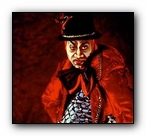
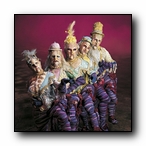
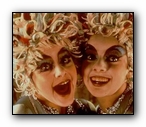
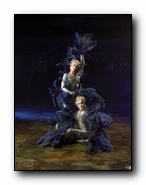
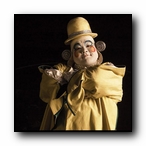
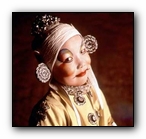
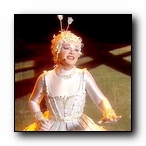
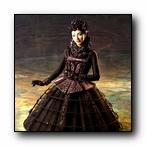
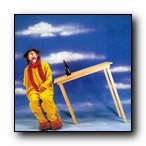
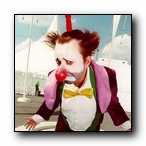
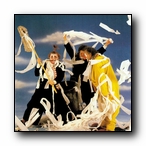
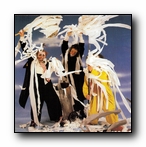
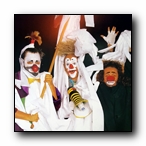
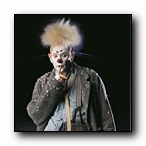
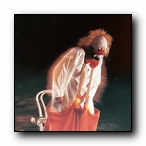
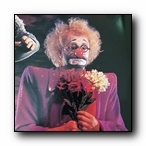
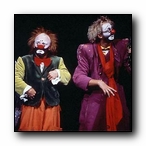
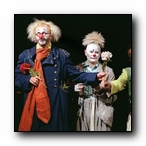
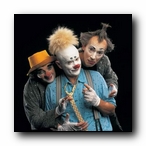
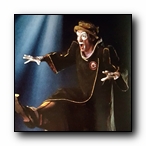
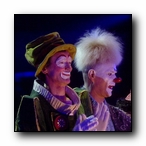
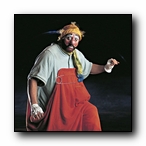
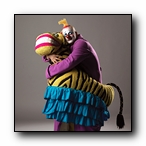
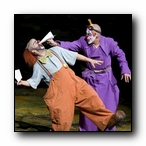
|
|

![]()




